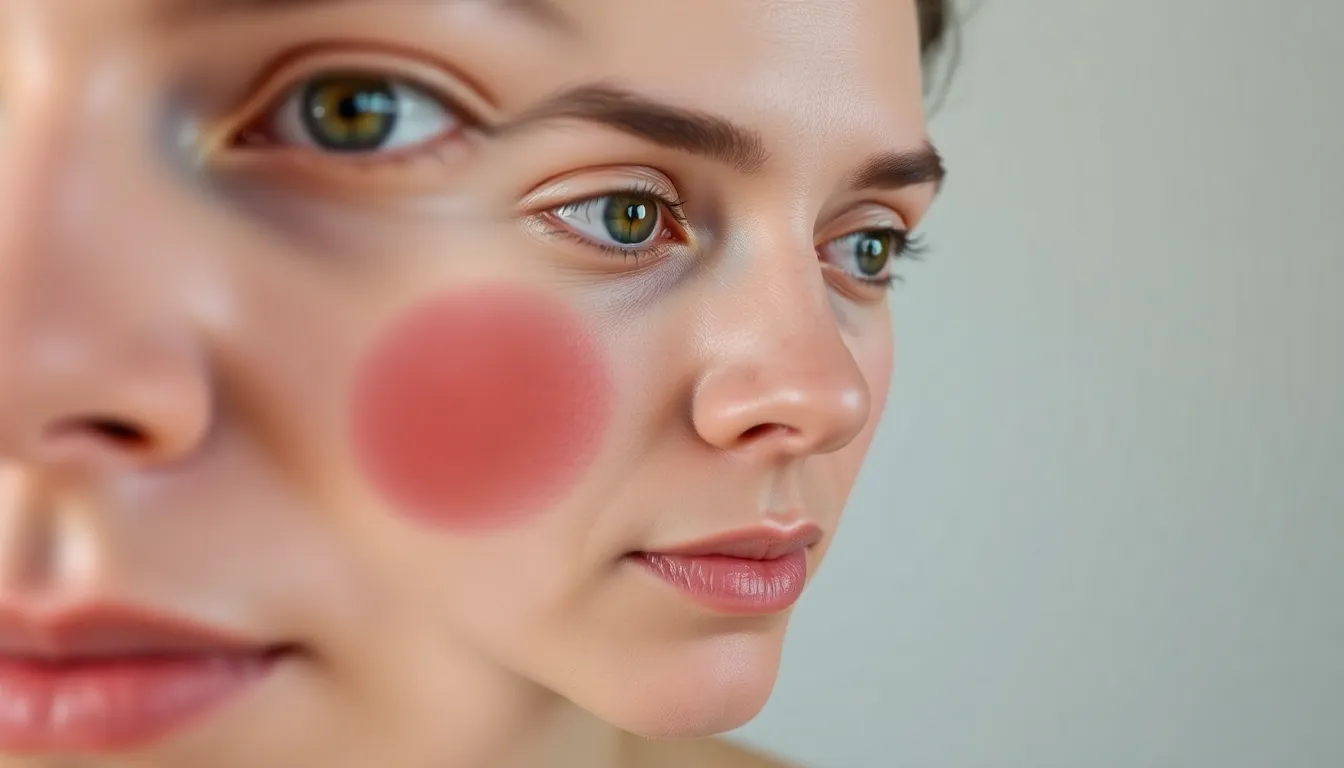Table of Contents
ToggleYeast infections aren’t just a pesky problem down below; they can pop up on the face too, and they’re not shy about making an appearance. Imagine waking up to a face that feels like it’s auditioning for a role in a horror movie. While it sounds like a plot twist straight out of a comedy, understanding this condition is no laughing matter.
In this article, we’ll explore the surprising world of facial yeast infections. With a mix of informative insights and eye-catching photos, readers will learn to identify the signs and symptoms. So, buckle up and get ready to navigate the wild and wacky realm of yeast infections on the face—because who knew skin issues could be so entertaining?
Understanding Yeast Infections
Yeast infections occur when there’s an overgrowth of the fungus Candida. This fungus naturally exists in small amounts on the skin and inside the body. Sometimes, factors like humidity, hormonal changes, or weakened immune systems lead to an imbalance, resulting in infections.
Symptoms can include redness, swelling, and sometimes painful or itchy patches. Facial yeast infections may also cause scaling or flaky skin. Diagnosis typically involves a physical examination, where a healthcare provider assesses the affected area. They may also take a swab for laboratory testing to confirm the presence of Candida.
Treatment usually involves topical antifungal medications. These medications target the overgrowth and provide relief from symptoms. Some people might require oral antifungal treatments if the infection is extensive or doesn’t respond to topical therapy.
Prevention strategies play an essential role in managing yeast infections. Keeping the face clean and dry helps reduce moisture buildup. Choosing breathable fabrics for clothing and avoiding excessive use of makeup can also support skin health.
Recognizing the signs early leads to quicker treatment and less discomfort. Awareness of conditions that can trigger yeast infections, such as stress or certain medications, is crucial. Understanding these factors contributes to better skin care and overall well-being.
Causes of Yeast Infections on the Face

Yeast infections on the face stem from an overgrowth of the Candida fungus, commonly found on the skin. Several factors contribute to this imbalance.
Common Risk Factors
Certain conditions increase the likelihood of developing a yeast infection on the face. High humidity promotes fungal growth, especially in warm climates. Hormonal changes, such as those during pregnancy or menstrual cycles, can trigger outbreaks. Individuals with weakened immune systems are also at higher risk due to reduced ability to fight infections. Other contributors include antibiotic use, which can disrupt the natural skin flora. Stress may weaken immune responses, making the body more susceptible.
Types of Yeast Infections
Different types of yeast infections can affect the face. Candidiasis, the most common type, creates red, itchy patches on affected areas. Orbital cellulitis represents a more serious infection involving the skin around the eyes and requires prompt medical attention. Pityriasis versicolor may also resemble yeast infections, causing discolored patches on the skin. Identifying the specific type can help determine the appropriate treatment and ensure better management.
Symptoms to Look For
Recognizing symptoms of a yeast infection on the face can lead to earlier intervention and relief. Observing certain signs is crucial for proper diagnosis.
Visual Indicators
Redness often appears on affected areas, signifying inflammation and irritation. Swollen patches can develop, making the skin look puffy and inflamed. Scaling or flaky skin frequently accompanies the redness, suggesting dryness or irritation. Small, raised bumps may arise, further indicating an infection. In severe cases, pustules could form, resembling acne but resulting from yeast overgrowth.
Other Accompanying Symptoms
Itching commonly occurs alongside visible signs, often leading to discomfort. Burning sensations may also develop, intensifying the urge to scratch. Increased sensitivity to touch can heighten discomfort, making routine activities challenging. In some instances, a thick white discharge might occur if the infection spreads. Feeling fatigued can serve as a systemic symptom, especially if the immune system struggles to manage the infection. Observing these symptoms is vital for identifying and treating facial yeast infections effectively.
Photos of Yeast Infection on Face
Visual aids play a crucial role in understanding yeast infections on the face. Accurate photos help individuals identify symptoms quickly and effectively, enabling early intervention.
Importance of Visual Documentation
Visual documentation enhances recognition of yeast infection symptoms. Images provide clear examples of redness, swelling, and flaky patches, facilitating quicker diagnosis. Additionally, patients benefit from seeing variations in infection severity. Such visuals promote awareness about treatment options, guiding choices between home remedies and medical care. By seeking out reliable images, individuals connect symptoms with authentic cases. Visibility leads to improved understanding and encourages proactive measures.
Analyzing the Photos
Analyzing photos reveals important insights about facial yeast infections. Close examination shows variations in skin texture, discoloration, and associated symptoms. Photographs often depict multiple stages of infection, illustrating how conditions evolve. By comparing images, individuals can discern the difference between mild symptoms and more severe manifestations. Careful observation highlights common traits, aiding in self-assessment. Users should remain mindful of differences among various types of infections, as not all presentations resemble typical cases. Such analysis fosters informed decision-making and better management of one’s skin health.
Treatment Options
Facial yeast infections require prompt attention to minimize discomfort and prevent worsening symptoms. Various treatment options exist, including home remedies and medical interventions.
Home Remedies
Natural solutions can provide relief from mild yeast infections. Coconut oil works effectively due to its antifungal properties. Applying diluted apple cider vinegar can restore the skin’s pH balance and inhibit fungal growth. Aloe vera offers soothing effects and aids in skin recovery. Keeping the affected area dry and clean proves essential for preventing further irritation. Regularly washing the face with mild soap also helps in managing symptoms. Lastly, incorporating probiotics into the diet supports overall skin health by promoting a balanced microbiome.
Medical Treatments
When infections escalate, medical treatments may be necessary. Topical antifungal creams often serve as the first line of defense. Common medications include clotrimazole and miconazole, which target fungal cells directly. For severe or persistent cases, oral antifungal medications may be prescribed. Doctors might recommend fluconazole or itraconazole depending on the situation. It’s important to consult a healthcare professional for appropriate diagnosis and treatment. Following the treatment plan consistently enhances the effectiveness of these medical interventions.
Prevention Strategies
Maintaining cleanliness is vital to prevent facial yeast infections. Regularly washing the face with a mild soap removes excess oil and debris that can promote fungus growth. Keeping the skin dry is equally important; moisture creates an environment where yeast thrives.
Choosing breathable fabrics can help minimize irritation and sweating. Fabrics made from natural fibers encourage airflow, which contributes to healthier skin. In addition, reducing the use of heavy makeup allows the skin to breathe, decreasing the likelihood of infection.
Managing stress plays a significant role in preventing yeast infections. High-stress levels can weaken the immune system, making the body more susceptible to fungal overgrowth. Engaging in stress-relieving activities can enhance overall well-being and strengthen the immune response.
Awareness of potential triggers is also crucial. Hormonal changes linked to menstruation or pregnancy may increase vulnerability to yeast infections, so monitoring body changes can be beneficial. Additionally, limiting antibiotic use can help preserve beneficial bacteria that control yeast levels on the skin.
Utilizing probiotics can enhance skin health by promoting a balanced microbiome. Foods like yogurt or supplements containing beneficial bacteria can support the immune system. Incorporating these into the diet can effectively support overall skin and body health.
Recognizing early symptoms remains an essential strategy. Keeping an eye out for redness, swelling, or itching ensures quick intervention and treatment. In case of persistent symptoms, seeking professional advice helps ensure timely and appropriate care.
Understanding yeast infections on the face is crucial for effective management and prevention. Recognizing the symptoms early can lead to timely treatment and reduce discomfort. By maintaining proper skin hygiene and being aware of potential triggers, individuals can significantly lower their risk of developing these infections.
Visual aids play a key role in identifying symptoms and fostering informed decisions about skin health. Whether it’s through home remedies or medical treatments, addressing facial yeast infections promptly is essential. With the right knowledge and proactive measures, individuals can ensure healthier skin and overall well-being.







